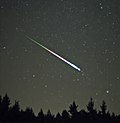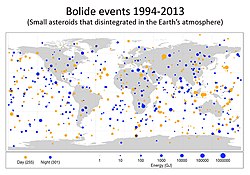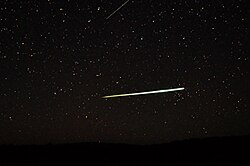Meteor
A meteor is what you see when a space rock falls to Earth. It is often known as a shooting star or falling star and can be a bright light in the night sky, though most are faint. A few survive long enough to hit the ground. That is called a meteorite, and a large one sometimes leaves a hole in the ground called a crater.
A rock that has not yet hit the atmosphere is called a meteoroid. Meteoroids may range in size from large pieces of rock to tiny dust particles floating in space that did not form planets. When the meteoroids enter Earth's atmosphere they are usually going faster than the Earth's escape velocity of 13 km/sec or Mach 40. This makes them heat up and usually break apart. When the heat makes them glow, they are known as meteors.
Meteors are distinct from comets or asteroids, but some, especially those associated with meteor showers, are dust particles that came out of comets.
There are several types of meteorites including: stony, carbonaceous chondrites, and iron-nickel. Stony meteorites are named because they are largely made up of stone-like mineral material. Carbonaceous chondrites have a high carbon content. Iron-nickel meteorites are mostly iron often with significant nickel as well.
Meteorites happened often during the Late Heavy Bombardment. Nowadays they sometimes hurt people and property. The 2013 Russian meteor event did the most damage. Large meteorite strikes may have played a part in several of the mass extinctions, and so indirectly on the course of evolution. (see K/T extinction event; List of extinction events; Chicxulub crater)
Meteorite types
Chondrites
Chondrites are stony (non-metallic) meteorites that are as old as the Solar System: 4.55 billion years.[1] They sometimes contain amino acids and other organic molecules.
They have not been modified due to melting or other disturbances. They are formed when various types of dust and small grains that were present in the early solar system accreted to form primitive asteroids. They are the most common type of meteorite that falls to Earth: they are about 85 or 86 percent of all meteorites.[2]
Their study gives clues about the origin and age of the Solar System, the synthesis of organic compounds, the origin of life or the presence of water on Earth. Chondrites can be differentiated from iron meteorites by their low iron and nickel content.
Carbonaceous chondrites
In 2021, a meteorite crashed on the Gloucestershire town of Winchcombe. It contained water that was a near-perfect match for that on Earth. The meteorite was picked up soon after it landed.[3] This is a suggested source for the water on Earth.
Achondrites
About 8 percent of meteorites show signs of melting and recrystallizing. They look rather like basalt or granite.
Iron meteorites
Iron meteorites are meteorites made of an iron–nickel alloy. They are about 6 percent of all meteorites. This comes from the inner cores of early small proto-planets.[4] The iron found in iron meteorites was one of the earliest sources of usable iron, before humans invented smelting. That signalled the beginning of the iron age. Iron meteorites are easily found, because they are very different from Earth rocks.
Siderolites
Siderolites are stony-iron meteorites that have almost equal parts of iron and silicates. They are quite rare: only about 1 percent of all meteorites are siderolites.
Meteor Media
Meteor seen from the site of the Atacama Large Millimeter Array (ALMA)
Camera recording of a superbolide passage above Chelyabinsk Oblast, Russia on 15th February 2013. The object in this video is estimated to be Template:Measurement converter in diameter before atmospheric entry.
A meteoroid of the Perseids with a size of about ten millimetres entering the earth's atmosphere in real time. The meteoroid is at the bright head of the trail, and the ionisation of the mesosphere is still visible in the tail.
A meteor of the Leonid meteor shower; the photograph shows the meteor, afterglow, and wake as distinct components
Multiple meteors photographed over an extended exposure time during a meteor shower
Meteor shower on chart
World map of large meteoric events (also see Fireball below)
Orionid meteor
Sporadic bolide over the desert of Central Australia and a Lyrid (top edge)
Meteor (center) seen from the International Space Station
Related pages
References
- ↑ The use of the term non-metallic does not imply the total absence of metals.
- ↑ Bischoff, A.; Geiger, T. (1995). "Meteorites for the Sahara: find locations, shock classification, degree of weathering and pairing". Meteoritics. 30 (1): 113–122. Bibcode:1995Metic..30..113B. doi:10.1111/j.1945-5100.1995.tb01219.x. ISSN 0026-1114.
- ↑ Amos, Jonathan 2022. Winchcombe meteorite bolsters Earth water theory. [1]
- ↑ M.K. Weisberg; T. J. McCoy & A.N. Krot (2006). "Systematics and evaluation of meteorite classification". In D.S. Lauretta & H.Y. McSween, Jr. (ed.). Meteorites and the early Solar System II (PDF). Tucson: University of Arizona Press. pp. 19–52. ISBN 978-0816525621. Archived from the original (PDF) on 2017-08-08. Retrieved 2012-01-01.
+{{{1}}}−{{{2}}}












